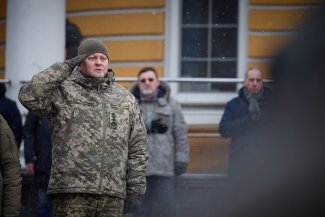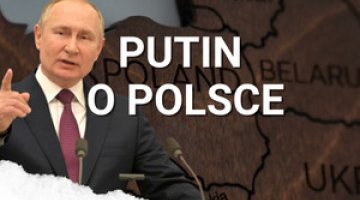Ukrainian generals predict a tough 2024. Day 672 of the war

On 25 December, Russia’s defence minister Sergei Shoigu officially announced the capture of Marinka. The previous day, Russian troops had reached the town’s administrative borders (a built-up area which they have controlled since mid-December, when the defenders withdrew to the north-western outskirts of the town), and the next day they reached Heorhiivka, which lies alongside it to the west. The Russians also recorded further advances south of Marinka, i.e. north-west of Bakhmut, where they levelled the front line about 3 km from Chasiv Yar. They also moved slightly north and north-west of Avdiivka, while holding off a Ukrainian counterattack west of that town, and made progress south of Siversk and west of Kreminna. South of Orikhiv in Zaporizhzhia oblast, the invaders pushed a wedge into the Ukrainian grouping between the villages of Robotyne and Verbove. According to some sources, this forced the withdrawal of defenders from the former (the Russians are also attacking Robotyne from the west); fierce fighting took place there during the Ukrainian offensive in the south during the summer. Meanwhile Verbove has been under Russian control all the time.
Starting on the evening of 22 December, Russian kamikaze drones attacked Odesa oblast for five consecutive nights, causing damage to infrastructure in and around Odesa city and Chornomorsk. On four occasions from 23 to 26 December, the town of Starokostiantyniv in Khmelnytskyi oblast was also targeted by Shahed drones. On 27 December, Russian kamikaze drones struck Chernihiv (elements of the power infrastructure was affected) and Mykolaiv oblasts (warehouses at an industrial site were damaged); from 23 to 25 December there were drone attacks on Dnipropetrovsk oblast (infrastructure was reported to have been damaged in Kryvyi Rih, in the region of Synelnykove, and in the areas of Dnipro and Pavlohrad cities). According to the Ukrainian Air Force Command, on 27 December the defenders shot down a total of 32 out of 46 Shahed-136/131 drones used by the invaders, 13 out of 19 the day before, 28 out of 31 on 25 December, 14 out of 15 on 24 December, and 19 out of 23 on 22–23 December. Seven out of eight Shaheds were also downed on the night of 28 December. The Ukrainian General Staff gave slightly different statistics, reporting the destruction of 29 out of 31 Russian kamikaze drones on 25 December, and 15 out of 16 on 24 December.
On 23 and 24 December, Kropyvnytskyi was targeted by Russian ballistic missiles (the invaders used at least four missiles in total). Initially, the local military administration reported the destruction of the enemy missiles and minor damage to civilian infrastructure caused by shrapnel. However, the reports of shootdowns were not confirmed by the Ukrainian General Staff in their later communiqués. It is most likely that military infrastructure was hit. According to the General Staff, the Russians used a total of 23 ballistic and cruise missiles between 23 and 27 December, of which the defenders were said to have shot down three.
The massive shelling of Kherson on 26 December caused severe damage to the local energy infrastructure. According to the Ukrainian energy ministry, 93,700 users lost their power supplies on that day. Taking the effects of the previous shelling of the city into account, 70% of all electricity consumers in the city were deprived of power. On 24 December the Ukrainian side also reported the mass-scale shelling of Kherson, during which civilians were killed and wounded. According to Ukrenerho, a heat & power station in Donetsk oblast was shelled once again on 28 December.
On 22 December, Ukrainian air defences shot down a group of three Su-34 frontline bombers, most likely using a Patriot system battery deployed in the south (according to some sources, one located in Kherson oblast). According to Ukrainian sources, this caused a temporary halt to Russian glide bomb attacks (modified KAB-500s), although these resumed on 27 December. However, reports by the Ukrainian army and government that another Su-34 and a Su-30 multi-role combat aircraft were shot down two days later have not been confirmed.
On the night of 26 December, Ukrainian Storm Shadow cruise missiles hit Feodosia in Crimea. The strike sank the landing ship Novocherkassk, which according to some sources had been transporting Shahed kamikaze drones; the ship had already been damaged in March 2022 in Berdyansk. According to unofficial information, out of the crew of 77, 33 sailors were killed or missing and 19 were injured. In addition, a disused UTS-150 training unit and a railway station were damaged. On the evening of 27 November, a series of explosions occurred in occupied Sevastopol, and local sources reported that Ukrainian kamikaze drones had been shot down.
On 25 December, the cabinet of ministers submitted a draft law to the Ukrainian parliament on amending certain legal acts to improve specific issues of mobilisation, military records and military service. Its provisions include lowering the upper age limit for men subject to conscription as part of mobilisation in wartime from 27 to 25 years; the possibility of demobilising soldiers who have served 36 months continuously during wartime, with a guarantee of two years’ exemption from subsequent conscription; the abolition of basic service and the release of all soldiers in this category to the reserves; and introducing compulsory military training, lasting from three to five months in peacetime. The bill also includes proposals to implement a number of changes in the way mobilisation summonses are handed out; to register men subject to compulsory military service in wartime who live abroad permanently; and to introduce harsher penalties for avoiding reporting for military service. Two days later, finance minister Serhiy Marchenko said he expected the Armed Forces Command and the defence ministry to submit proposals for optimising spending. He stressed that the state’s financial capacities in this area have now been exhausted, and that an automatic increase in the budget if a large number of people are to be mobilised will no longer be possible.
On 26 December General Valerii Zaluzhnyi, Commander-in-Chief of the Armed Forces of Ukraine, and Chief of General Staff General Serhiy Shaptala held a press conference. Referring to the draft mobilisation law, Zaluzhnyi repeatedly stressed that the army is not responsible for preparing the legal framework for mobilisation, as it is engaged in conducting combat operations, and its leadership can only present its needs and expectations for conscription and supplies of materiel to the civilian authorities. Zaluzhnyi also distanced himself from the statement by President Volodymyr Zelensky on 19 December that the Armed Forces Command was demanding the mobilisation of half a million people. Without giving specific figures, he pointed out that the needs of the front and the attrition of men from the ranks required a constant flow of replenishment, and that a one-off mobilisation of hundreds of thousands was pointless at this stage of the war, and no such move was being planned.
Zaluzhnyi also referred to the current situation at the front and its prospects for the immediate future. Challenging the declarations by some generals about a continued defence of Marinka, he acknowledged that it had been lost and stated that “the town is no longer there”. He reported that “the army has prepared a new defence perimeter outside this settlement”. Referring to the defence of Avdiivka, he said that it would be maintained as long as there were enough forces. In the event of having to choose between defending the area and maintaining combat potential, the priority is to protect the lives of soldiers. According to Zaluzhnyi, the invaders’ resources allow them the freedom to concentrate their forces in any direction, and within two to three months “they could do to Avdiivka… what happened to Bakhmut”. The following day, the commander of the Ukrainian Land Forces, General Oleksandr Syrskyi, and the commander of the Tavria operational-strategic group of troops, General Oleksandr Tarnavskyi, spoke in a similar vein. The former assessed that the Ukrainian Armed Forces are in a difficult position in many areas, while the latter said that the next year could be even more difficult for the defenders than this year had been.
On 27 December, Newsweek reported that the first F-16 fighter jets promised by Ukraine’s Western partners may have already arrived there. The spokesman for the Ukrainian Air Force Command, Colonel Yuri Ihnat, dismissed these reports; in passing he appealed to people online not to spread reports about the deployment of F-16s in Ukraine, which he considered as being potentially dangerous to the defenders. In previous days, Russian media had reported that F-16 fighter jets were landing at airfields in western Ukraine and overflying its territory, with Ukrainian pilots training in Romania. On 26 December, the British government reported that the first six Ukrainian pilots had completed their basic training in the UK (conducted on Grob Tutor turboprop light planes) and had started a course in Denmark on flying F-16s. A further ten Ukrainian pilots are currently training in the UK. On 22 December, after a conversation with President Zelensky, Dutch prime minister Mark Rutte announced the preparation of the first 18 F-16 fighters for transfer to Ukraine. According to Ihnat, the modernisation of these aircraft is essential.
On 27 December, Washington announced a new $250 billion military support package for Kyiv. It included missiles for NASAMS launchers and components for air defence systems, Stinger missiles, missiles for HIMARS launchers, 155-mm and 105-mm artillery ammunition, anti-aircraft missiles for Stinger launchers and anti-tank missiles for TOW launchers, Javelin anti-tank guided missiles and AT-4 anti-tank grenade launchers, and 15 million small arms cartridges. On the same day, the German TV news programme Tagesschau reported that of the record €11.71 billion in German arms and military equipment exports in 2023, Ukraine accounted for the most with €4.15 billion (followed by Norway with €1.2 billion). A year earlier, the German arms industry exported equipment worth €2.24 billion to Ukraine. On 22 December, Berlin announced the transfer of another military support package. This includes three Gepard self-propelled anti-aircraft guns with 30,240 rounds of 35-mm ammunition for them, 10 Vector reconnaissance drones, two HX81 tractors and five trailers for them, eight Zetros trucks, 2500 155mm calibre artillery shells and an unspecified number of 120-mm ammunition rounds for Leopard 2A6 tanks, as well as 25,000 rounds for 40-mm automatic grenade launchers.
On 27 December, Ukrainian deputy defence minister Yuriy Dzhygyr presented a report on the ministry’s budget for 2024. It is planned to spend a record 1164 billion hryvnias ($30.2 billion), ten times more than in 2021. The minister did not rule out an increase in spending during the financial year. A sum of 751.3 billion hryvnias, or 65% of the total outlay, will be taken up by salary payments. In total, expenditure on personnel maintenance (in addition to pay for training and social security) will amount to 883 billion hryvnias. 265.4 billion hryvnias are to be spent on the development, purchase, modernisation and repair of equipment, with up to 175 billion hryvnias set aside for the purchase of ammunition, mainly outside Ukraine. The Ukrainian defence ministry, meanwhile, plans to spend most of the funds on getting Ukrainian industry to overhaul armaments and military equipment. A day earlier, the Ukrainian finance ministry reported that in the first 11 months of this year, a total of 1559.4 billion hryvnias ($40.5 billion) had been allocated to security and defence, accounting for 59.2% of total budget spending for the period.
Commentary
- The Ukrainian military’s comments on the situation at the front and its prospects for development in the runup to the third calendar year of the war differ significantly from those presented in December 2022. At that time, the leadership of the Ukrainian military intelligence service (HUR) led the way; they gave a narrative of a Ukrainian counter-offensive in the spring and the expulsion of the invaders from the occupied territories; some optimistic variants predicted the recovery of Crimea before the end of 2023. Alongside the HUR, the message was dominated by representatives of the Ukrainian government; meanwhile, the voices of army representatives were heard much less frequently, and they mostly tried to play down the widespread irrational exuberance, while not negating their expected successes. In contrast, the forecasts for 2024 are dominated by the messages of the Ukrainian army command, who are predicting another tough year of war, and say that maintaining the positions they currently hold is the main achievable goal. The change in narrative is primarily due to the failure of the Ukrainian counter-offensive this summer, the losses the defenders have suffered, and the perceived reduction in military support from the West. It should be seen as an attempt to adapt the message to the real situation, reports of which are reaching the majority of the Ukrainian public, and as a result undermining confidence in the more optimistic messaging of President Zelensky’s team.
- Amending the current mobilisation rules in order to replenish and refresh the army’s ranks is a pressing necessity. However, the draft mobilisation law has been met with criticism in Ukraine from opposition politicians, some journalists and volunteers, as well as some soldiers on active duty (via social media). In particular, critics have highlighted the low legislative level of the draft, including the use of convoluted and unclear provisions, as well as solutions that are questionable both from the legal point of view and in terms of sheer common sense. It has been pointed out that the president – who, under the constitution, is responsible for strategic planning and the decision to mobilise the army – has avoided taking responsibility, and has failed to explain to the public the seriousness of the situation and the need to increase the war effort. There was also outrage when the bill was tabled in parliament on Christmas Day, giving the impression of a deliberate move by the ruling camp to divert public attention from taking unpopular decisions. General Zaluzhnyi made a good impression at the press conference, presenting the needs of the Armed Forces on the threshold of the third year of the war in an understandable way, and not hesitating to talk about the problems piling up for the army and society – to the extent that this is possible in the public space.






